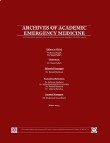An Epidemiologic Overview of Traumatic Vascular Injures in Emergency Department; a Retrospective Cross-Sectional Study
Vascular system injuries (VSIs) are one of the main causes of preventable mortality and morbidity of trauma patients. This study aimed to evaluate baseline characteristics, presenting signs, managements, and outcomes of patients presenting to emergency department (ED) with traumatic VSIs.
This retrospective cross-sectional study was conducted on patients with traumatic VSIs admitted to the ED of a referral tertiary trauma center, during one year. Using a pre-prepared checklist, demographics, pre-hospital care, type of VSIs, injury severity score (ISS), anatomical location of trauma, associated injuries, method of surgery, complications, and outcome were collected from patients’ profiles and reported.
One hundred and twelve patients with the mean age of 33.5 ± 14.7 (range = 8 - 80) years were studied (90.2% male). Most of the patients were categorized as mild or moderate in terms of their ISS. 90 (80.4%) patients had at least one soft sign and 99 (88.4%) patients had at least one hard sign. Isolated arterial injury was diagnosed in 90 (80.4%) patients, isolated venous injuries in 12 (10.7%) cases, and combined arteriovenous injuries in 10 (8.7%) patients. The most common associated injury was tendon rupture (63.4%) and nerve injuries were present in 60.7% of patients. 1 (0.9%) patient died, 6 (5.4%) patients went through amputation, and 3 (2.7%) patients were discharged against medical advice. The rest of the patients were discharged in perfect health. There was a significant correlation between trauma type (p = 0.001), upper and lower extremity trauma (p < 0.001), presence of distal ischemia and lack of pulse (p = 0.041), penetrating injury close to a major vessel (p = 0.006), type of injured vessels and arteries (p<0.001), injury to nerve (p = 0.011) and tendon (p = 0.007), presence of open fracture (p = 0.005), multiple trauma (p < 0.001), method of surgery (p < 0.001), and number of postoperative complications (p< 0.001) with poor outcome.
The findings showed that the majority of the studied patients were young males, most of whom were discharged in perfect situation. Those who presented with higher ISS, or were affected by blunt trauma or injury to lower limb arteries had worse outcome than the others.
- حق عضویت دریافتی صرف حمایت از نشریات عضو و نگهداری، تکمیل و توسعه مگیران میشود.
- پرداخت حق اشتراک و دانلود مقالات اجازه بازنشر آن در سایر رسانههای چاپی و دیجیتال را به کاربر نمیدهد.


